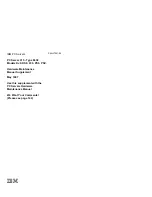
Configuring for Network Management Applications
LLDP (Link-Layer Discovery Protocol)
ProCurve# walkmib ifDescr
ifDescr.1 = D1
ifDescr.2 = D2
ifDescr.3 = D3
.
.
.
ifDescr.23 = X1
ifDescr.24 = X2
ifDescr.25 = C1
ifDescr.75 = DEFAULT_VLAN
.
.
.
Figure 13-31. Matching Internal Port Numbers to External Slot/Port Numbers
LLDP and CDP Data Management
This section describes points to note regarding LLDP (Link-Layer Discovery
Protocol) and CDP (Cisco Discovery Protocol) data received by the switch
from other devices. LLDP operation includes both transmitting LLDP packets
to neighbor devices and reading LLDP packets received from neighbor
devices. CDP operation is limited to reading incoming CDP packets from
neighbor devices. (ProCurve switches do not generate CDP packets.)
LLDP and CDP Neighbor Data
With both LLDP and (read-only) CDP enabled on a switch port, the port can
read both LLDP and CDP advertisements, and stores the data from both types
of advertisements in its neighbor database. (The switch only
stores
CDP data
that has a corresponding field in the LLDP neighbor database.) The neighbor
database itself can be read by either LLDP or CDP methods or by using the
show lldp
commands. Take note of the following rules and conditions:
■
If the switch receives both LLDP and CDP advertisements on the same
port from the same neighbor the switch stores this information as two
separate entries if the advertisements have differences chassis ID and port
ID information.
■
If the chassis and port ID information are the same, the switch stores this
information as a single entry. That is, LLDP data overwrites the corre
sponding CDP data in the neighbor database if the chassis and port ID
information in the LLDP and CDP advertisements received from the same
device is the same.
■
Data read from a CDP packet does not support some LLDP fields, such as
“System Descr”, “SystemCapSupported”, and “ChassisType”. For such
fields, LLDP assigns relevant default values. Also:
13-83
Summary of Contents for ProCurve 6120G/XG
Page 2: ......
Page 24: ...xxii ...
Page 40: ...Getting Started To Set Up and Install the Switch in Your Network 1 10 ...
Page 70: ...Using the Menu Interface Where To Go From Here 3 16 ...
Page 92: ...Using the ProCurve Web Browser Interface Contents Setting Fault Detection Policy 5 25 5 2 ...
Page 160: ...Switch Memory and Configuration Automatic Configuration Update with DHCP Option 66 6 44 ...
Page 288: ...Port Status and Configuration Uplink Failure Detection 10 42 ...
Page 318: ...Port Trunking Outbound Traffic Distribution Across Trunked Links 11 30 ...
Page 487: ...Monitoring and Analyzing Switch Operation Status and Counters Data B 17 ...
Page 518: ...Monitoring and Analyzing Switch Operation Traffic Mirroring B 48 ...
Page 612: ...MAC Address Management Viewing the MAC Addresses of Connected Devices D 8 ...
Page 616: ...Monitoring Resources When Insufficient Resources Are Available E 4 ...
Page 620: ...Daylight Savings Time on ProCurve Switches F 4 ...
Page 638: ...Network Out of Band Management OOBM Tasks G 18 ...
Page 659: ...download to primary or secondary flash A 21 using to download switch software A 19 Index 19 ...
Page 660: ...20 Index ...
Page 661: ......
















































